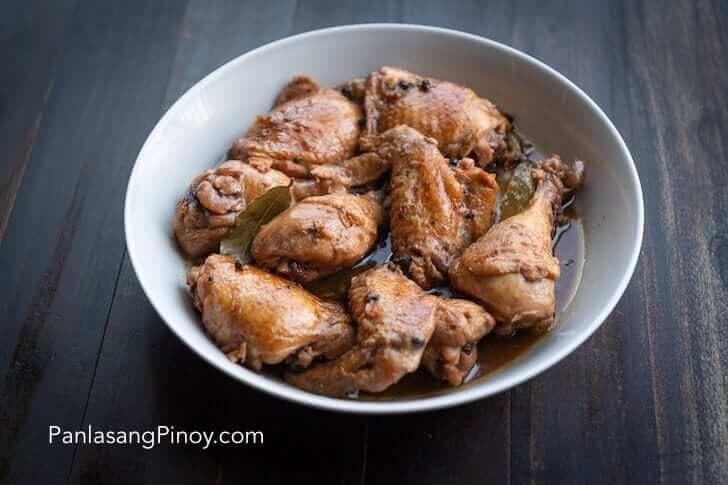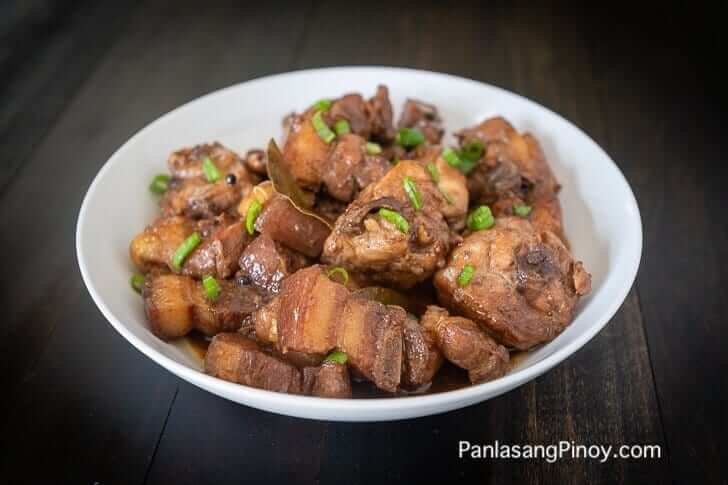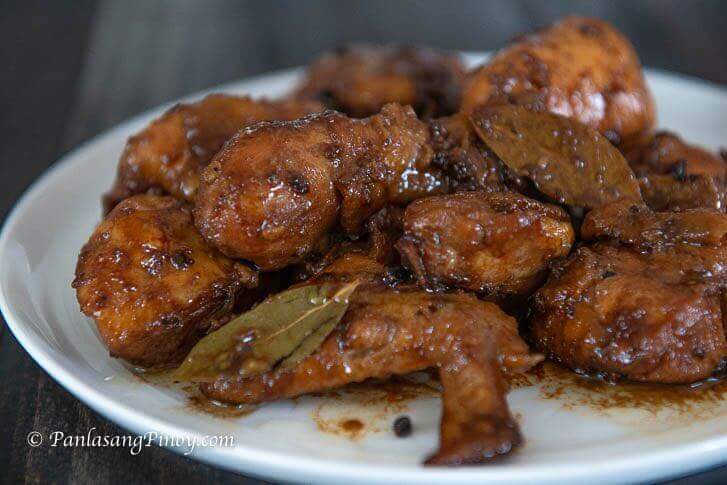Filipino Chicken Adobo Recipe
Chicken Adobo is an authentic Filipino dish and is one of the mostly recognized Filipino foods. Not to be mistaken with Mexican adobo, this dish is uniquely prepared by stewing chicken in vinegar and soy sauce.
This post may contain affiliate links. Please read our disclosure policy.
According to several experts in Asian food history, Filipinos were cooking adobo before Spanish colonization. Cooking with vinegar preserves meat, and is one of the earliest food preservation practices. This is also true of pork adobo, which is another popular variation of the dish.

While there have been several variations of adobo across the years, chicken adobo remains one of the most popular and for good reason!
The taste of juicy chicken in a succulent, umami adobo sauce makes chicken adobo a comfort food for all ages. From kids to adults, we can’t get enough of this mouthwatering meal!
How to Cook Chicken Adobo

- Marinate the chicken in soy sauce and garlic. The garlic needs to be crushed for best results. This process takes 1 hour to 12 hours depending on how flavorful you want the dish to be. Sometimes marinating for an hour is not enough. I think that 3 hours is optimal. The chicken absorbs most of the flavors from the soy sauce and garlic during this step. It is noticeable when you taste the dish after cooking. Note that it is also possible to include the vinegar in this step.
- Separate the chicken from the marinade. Make sure to set the marinade aside because it will be used later on.
- Pan-fry the chicken. Fry for 1 to 1 ½ minutes per side. This will partially cook the outer part. It also makes the skin tough enough to withstand stewing later. This means that it will remain intact, which is nice for presentation.
- Pour marinade into the pot and add water. Let boil. The bay leaves and whole peppercorn can now be added.
- Simmer for 20 to 25 minutes. It can take a it longer depending on the quality of the chicken. However, feel free to cook longer in low heat for a super tender chicken adobo. Add the vinegar. This can also be added as a part of the marinade. Let it cook for 10 minutes.
- Season and serve. Add sugar and salt. I only add salt if needed. It is important to taste your dish before adding seasonings. Filipino chicken adobo can be served with or without sauce. If you like it very tasty then continue to cook on an uncovered cooking pot until the liquid
Tips & Tricks
- Use any chicken part when cooking Filipino chicken adobo. The common parts that I use are thigh, drumstick, and breast.
- The most important part of cooking chicken adobo is the marinade. The longer you let your chicken marinate in the rich combination of adobo flavors, the tastier it’ll be! I tend to make multiple batches of chicken adobo, so I can cook adobo whenever I feel like it. The longer it stays in the freezer, the more your chicken is able to absorb adobo’s amazing taste.
- Dark Soy Sauce is common when for adobo. However, you may use any kind of soy sauce that you prefer. Using light soy sauce is not bad. Coconut aminos will also work.
- White vinegar is commonly used. Cane vinegar and apple cider vinegar works too.
- Garlic helps make adobo delicious. Use as many garlic as you prefer.
- Onions can also be used for chicken adobo. If this is the case, it will need to be sautéed after pan frying the chicken.
- If you want your chicken to be a lot tenderer before cooking, another option is to cook the chicken in a slow cooker or crockpot overnight. This will enhance the flavors and make the chicken much juicier.

Where did it originate?
The famous Chicken Adobo originated in the Philippines. The dish is prepared using the Inadobo style of cooking. It means cooking meat or seafood with vinegar and mostly soy sauce. It is a popular method during the olden days when refrigerators and freezers were not yet available because vinegar helps extend the shelf life of food.

How Long Would It Take to Make Chicken Adobo?
It may seem like a lot to take on such a popular recipe. Chicken Adobo may not seem like the best option to those people just starting out in the kitchen, but it will surprise you how simple it can be to create this, especially after you’ve had your first try. In fact, it takes me less than an hour to cook up my adobo. For this recipe, just an estimated 40 minutes is needed to craft the most pleasant, aromatic Chicken Adobo.
Prep time would be approximately 5 minutes since we actually won’t be slicing or mincing anything. We simply need to get our ingredients together before we cook for around 35 minutes in total. But understandably so, this may all take longer for beginner cooks. If you are having a hard time following the recipe from the steps written here, just click on the tutorial video linked at the bottom of this article. I will happily guide you through the process of making Chicken Adobo!
Try this Filipino Chicken Adobo Recipe and let me know what you think.
Did you make this? If you snap a photo, please be sure tag us on Instagram at @panlasangpinoy or hashtag #panlasangpinoy so we can see your creations!

Chicken Adobo
Ingredients
- 2 lbs chicken (note 1)
- 3 pieces dried bay leaves (note 2)
- 4 tablespoons soy sauce (note 3)
- 6 tablespoons white vinegar (note 4)
- 5 cloves garlic (note 5)
- 1 1/2 cups water
- 3 tablespoons cooking oil
- 1 teaspoon sugar (note 6)
- 1/4 teaspoon salt (note 7)
- 1 teaspoon whole peppercorn (note 8)
Instructions
- Combine chicken, soy sauce, and garlic in a large bowl. Mix well. Marinate the chicken for at least 1 hour. Note: the longer the time, the better2 lbs chicken, 4 tablespoons soy sauce
- Heat a cooking pot. Pour cooking oil.3 tablespoons cooking oil
- When the oil is hot enough, pan-fry the marinated chicken for 2 minutes per side.
- Pour-in the remaining marinade, including garlic. Add water. Bring to a boil1 1/2 cups water
- Add dried bay leaves and whole peppercorn. Simmer for 30 minutes or until the chicken gets tender3 pieces dried bay leaves, 1 teaspoon whole peppercorn
- Add vinegar. Stir and cook for 10 minutes.6 tablespoons white vinegar
- Put-in the sugar, and salt. Stir and turn the heat off.Serve hot. Share and Enjoy!1 teaspoon sugar, 1/4 teaspoon salt
Notes
- Chicken: slice the chicken into serving pieces before cooking. The cuts are usually smaller. For example, a regular piece of chicken breast can be divided into 2 to 3 pieces depending on your preference.
- Bay leaves: This is an essential ingredient for Filipino adobo as far as I am concerned. Dried bay leaves (locally called “dahon ng laurel”) are usually used because of it is available year round. It can also be stored longer in room temperature. However, fresh bay leaves can also be utilized for this recipe.
- Soy sauce: I personally prefer Filipino brand soy sauce in making adobo. I have nothing against Kikkoman and other Asian brands, but the dish will taste more authentic if local soy sauce is used.
- Vinegar: White vinegar is the most common type to use for adobo. Sometimes I use cane or rice vinegar too.
- Garlic: Adobo should be garlicy. The garlic can be sauteed and boiled just like in this recipe, or it can be toasted. I toast this by browning the crushed garlic in oil before adding the chicken. Sometimes I make extra toasted garlic so that I have more for garnish later on.
- Sugar: this is an optional ingredient. Sugar is added to balance the saltiness of the dish. You can add more too if you want your chicken adobo to be on the sweet side.
- Salt: This is optional because the soy sauce is already salty to begin with. I only add salt when needed, which is not usual.
- Peppercorn: It does not matter if it is is whole, crushed, or ground. Whole peppercorn has just been used traditionally.




Tony. says
As delicious as the pork Adobo,
One question though, how do you get more gravy (juice) without making it too watery,
Vanjo Merano says
Hi Tony, you can omit the water. Make sure to cook the chicken covered in low heat (simmer). The natural juices will come out helping to cook the chicken in the process.